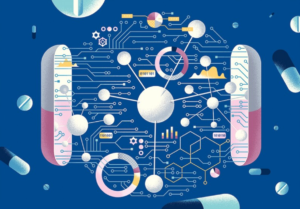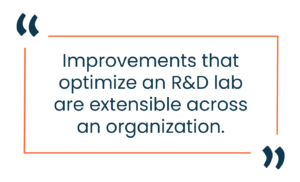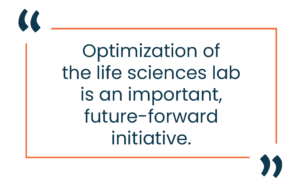 Labs are resetting the trajectory for drug development: reducing timelines from years to months; decreasing costs from billions to millions; and gaining an advantage by delivering drugs to market in months rather than decades.
Labs are resetting the trajectory for drug development: reducing timelines from years to months; decreasing costs from billions to millions; and gaining an advantage by delivering drugs to market in months rather than decades.
This value combination is a compelling case for investment in digital capability and organizational transformation.
A 100x or 1000x advance in lab efficiency is an achievement that is within reach for R&D labs, and the time has never been more important than now to grasp opportunities for change. The race to market is driving organizations toward higher efficiencies, yet scientific iteration is constrained by access to critical data. Without scalable solutions for connecting data to analytical systems, lab performance will lag.
Our experience suggests that R&D lab performance is challenged by a traditional scope for evolving the lab that limits change to small work groups and restrains new technologies within specialized areas of science.
Our vision is to empower scientists and engineers to gain and retain the skills necessary to accelerate their science in an R&D environment that is optimized for scientific creativity and productivity.
One of the best examples of an optimized R&D environment is a lab that harnesses new technologies to connect with data, automate measurements and data ingestion, and applies AI & machine learning techniques to run volumes of iterative tests, capturing results as analytics-ready data. Scientists in this type of optimal environment are working within their best scientific capacities and advancing science to help the organization adapt and realize its full business potential.
In our observations of the life sciences market, we have seen significant successes that are attributed to focused efforts that transform R&D holistically as new digital technologies are introduced, and scientific staff develop the skills to work nimbly and autonomously. In one example of MIT using AI to discover a new antibiotic, a team of scientists made a ground-breaking discovery-a new molecule-that had an inhibiting effect on E. Coli bacteria. The interactive process was simplified to run computations at an unprecedented new rate that led to life-saving discovery.
 Improvements that optimize an R&D lab are extensible across an organization. In the article “Ten battlegrounds for digital and analytics in life sciences” McKinsey takes a broad organizational view and outlines 10 ‘battlegrounds’ that represent significant opportunities for value creation within life sciences. McKinsey argues that digital success comes from picking your battles and focusing on the system as a whole.
Improvements that optimize an R&D lab are extensible across an organization. In the article “Ten battlegrounds for digital and analytics in life sciences” McKinsey takes a broad organizational view and outlines 10 ‘battlegrounds’ that represent significant opportunities for value creation within life sciences. McKinsey argues that digital success comes from picking your battles and focusing on the system as a whole.
Each battleground is “… an area of the business system where it is possible to deliver value at scale through a “platform solution,” whereby specific data sets, data and analytics platforms, analytical models, and digital experiences for customers and end-users are brought to bear upon a cluster of closely related digital and analytics use cases.”
But, what “platform solution” is the right solution to provide the foundation for change? Rather, what partner can facilitate lasting change?
In our view, there are three central building blocks that uphold the foundation, and it takes a very particular partner to bring about a successful transformation. To frame the top 3 values in selecting a partner, we highlight the following:
- Process-oriented partnership
- Technology leadership
- People-centric model
Scaling digital innovation across the organization requires taking the long view, with leadership that is committed to providing governance and sponsoring digital innovation initiatives. Chris Llewelln, Senior Partner at McKinsey in London, states, “Without such sponsorship and a narrative that makes clear the need for change, most business leaders will stay focused on short-term profit and loss targets, lacking any incentive to do things differently.”
These are the incremental advances from digital technologies that the organization knows how to scale.
A digital strategy must include objectives that encourage the R&D lab to pursue possibilities, not just incremental advances. “It cannot be assumed that if investments in people, data, and technology are made, value will follow. A business case must be made at the outset, then reviewed at least quarterly to ensure the link to value holds firm.” (Llewelln)
Making a convincing business case for possibilities through lab R&D is much more challenging than one for incremental advances, which typically offer line of sight to value in the near-term, such as the next two quarters. 
Optimization of the life sciences lab is an important, future-forward initiative. It is critical that science-driven organizations be able to exploit these advances as they become available, whether in their enabling ‘platform’ or the advanced software solutions that will run on it.
Delivering early business value through initiatives targeting digital innovation is critical. Without an early win, teams and organizations can lose interest, and leadership moves on to focus on other projects, tools, and initiatives that provide clear value. These projects, tools and initiatives often provide only incremental improvements, measured quarterly, whilst the possibilities enabled by advanced digital capabilities are missed.
The R&D labs of the life sciences sector are preparing to embrace change. At Enthought, we are here to support companies with the highest empowering solutions to advance their science and technology, and accelerate their path to market success. We are ready to build out the next solution to scale and redirect the trajectory of scientific pursuits.
Ultimately our work begins in the R&D lab by equipping scientists with the power of rapidly advancing scientific software tools and techniques. For more information on the Enthought approach to transforming the R&D lab, Contact Us and we will be happy to respond.
Related Content
Enthoughtが定義する、製薬会社の研究開発ラボにおける真のDX
Enthought GKチームは、東京で開催されたライフサイエンスカンファレンス「ファーマIT&デジタルヘルスエキスポ2022」に出展し、技術的な見識と市場成長の活性化を求めて集まる製薬業界のリーダーたちと会談しました。三日間の会期中に200社が出展し、6700人以上の参加者が集まりました。 デジタルトランスフォーメーションが主要テーマである本展示会は、当社のターゲットとする企業に、製薬業界の新薬開発を加速させる当社のサービスを
科学における大規模言語モデルの重要性
OpenAIのChatGPTやGoogleのBardなど、大規模言語モデル(LLM)は自然言語で人と対話する能力において著しい進歩を遂げました。 ユーザーが言葉で要望を入力すれば、LLMは「理解」し、適切な回答を返してくれます。
Life Sciences Labs Optimize with New Digital Technologies and Upskilling
Labs are resetting the tr…
From Data to Discovery: Exploring the Potential of Generative Models in Materials Informatics Solutions
Generative models can be used in many more areas than just language generation, with one particularly promising area: molecule generation for chemical product development.
The Importance of Large Language Models in Science Even If You Don’t Work With Language
OpenAI's ChatGPT, Google's Bard, and other similar Large Language Models (LLMs) have made dramatic strides in their ability to interact with people using natural language....
Leveraging AI in Cell Culture Analysis
Mammalian cell culture is a fundamental tool for many discoveries, innovations, and products in the life sciences.
Making the Most of Small Data in Scientific R&D
For many traditional innovation-driven organizations, scientific data is generated to answer specific immediate research questions and then archived to protect IP, with little attention paid...